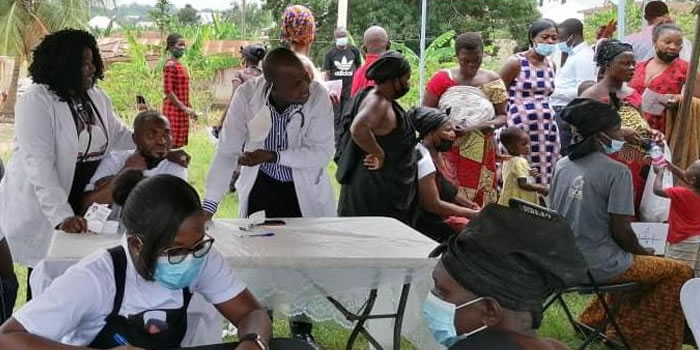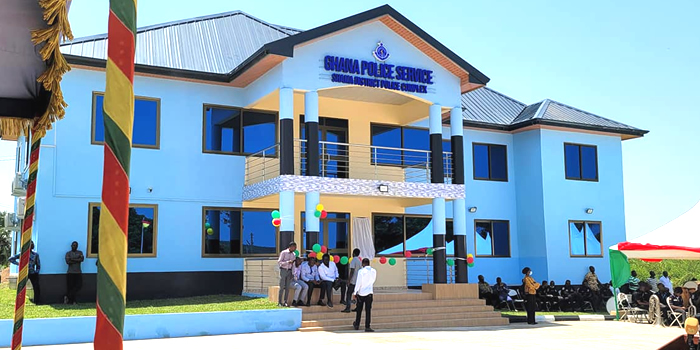

Introduction
Demography is concerned with virtually everything that influences or can be influenced by a population size, distribution, processes, structure, or characteristics (Weeks, 1998). In order to analyze the demography of an area, it is important to understand the population size, geographical distribution, fertility, mortality, migratory patterns, the age sex structure and the dependency ratio among others.
In this chapter, information collected on the various demographic characteristics of the population in the District during the 2010 Population and Housing Census is discussed.
Population Size and Distribution
Table 2.1 provides data on total population by age-sex structure. From the Table, Shama has a total population of 81,966 persons with the population of females is 43,262 (52.8%) higher than the males (38,704). The data in Table 2.1 shows that a greater proportion of the population are aged 0-4 years (14.3%), with the proportion of males (15.4%) higher than the females (13.3%). The Table further indicates that, proportions of males aged 0-19 years are higher than the female proportions in the same age group. However, from the age 2054, the proportions of females are higher than the males. The age structure shows a pattern of population decreasing as age increases, suggesting the effect of mortality and migration.
Age-Sex Structure, Sex Ratio and Population Pyramid
Age and sex structure of a population are vital characteristics of a population which influence many demographic issues. Understanding the age and sex structure of a population yields insights into the dynamics of the population composition and highlights on socio-economic challenges
Age- sex structure
The age-sex structure of the population of the District is a reflection of typical demographic pattern observed in developing countries where high fertility and mortality rates are observed. This situation is characterized by a high proportion of children less than 15 years (41.2%) with proportion of males (44.2%) higher than females (38.5%) as shown in Table 2.2. The proportion of elderly persons 60 years and older (6.7%) is the lowest in the age groups. Table 2.2: Age structure by sex and age group
Age Group
Both Sexes Males Females Number Percent Number Percent Number Percent All Ages 81,966 100.0 38,704 100.0 43,262 100.0 Under 15 33,769 41.2 17,112 44.2 16,657 38.5 15 - 24 16,220 19.8 8730 22.6 8490 19.6 25 - 29 5,745 7.0 2467 6.4 3,278 7.6 30 - 59 20,780 25.4 9267 23.9 11,513 26.6 60 + 5,452 6.7 1,128 2.9 3,324 7.7 Source: Ghana Statistical Service, 2010 Population and Housing Census
Population pyramid
A population pyramid is a graphical representation of the age-sex composition of a population. Its shape is influenced by the levels of fertility, mortality, migration and coverage and content errors such as digit preference and exaggeration of age. The broadness of the base is determined by the level of fertility, while the shape is determined by mortality and to some extent migration. Figure 2.2 is a pyramid representing the structure of the total population by sex of the Shama District in 2010. The data shows that the District has a youthful population with the concentration in age group 0-4, depicting a broad based with the percentage in higher ages reduces gradually in subsequent age groups with a small number of elderly and more females than males at advanced years.
The dependency ratio (persons under 15 years of age plus persons 65 years and older to the working age population of 15-64 years) for the District is 84.93 as shown in Table 2.3, it is higher than the National and Regional ratios of 75.6 and 74.8 respectively (GSS, 2010 PHC Regional Analytical Report, 2013). Male dependency ratio (92) is higher than females (79). Child dependency ratio is 76.2, while old age dependency is 8.7.
Sex ratio
Sex ratio is the number of males per 100 females in a population or a defined geographic area. Table 2.4 shows sex ratios by locality. The sex ratio for all ages in the Shama District is 89 as shown in the Table. This indicates that for every 100 females in the District, there are 89 males. However, sex ratio in the rural areas (91.9) is higher than in the urban areas (87.6).
Fertility, Mortality and Migration
Fertility
Fertility refers to the number of live births a woman has in her reproductive age. The Total Fertility Rate (TFR) is the average number of children that would be born to a woman by the time she ended childbearing if she were to pass through all her childbearing years conforming to the age-specific fertility rates of a given year (Population Handbook, 5th Edition). Crude Birth Rate (CBR) refers to the number of births per 1000 women. General Fertility Rate (GFR) on the other hand, expresses births relative to the number of women in the reproductive age. More data are required to calculate the GFR than the CBR because one has to know the age and sex composition of the population. The GFR is affected by age structure since there may be substantial variations between populations within the reproductive age range. Table 2.5 presents information on fertility and Crude Birth Rate by district.
The table shows that Western Region has a Total Fertility Rate of 3.57, General Fertility Rate of 89.2 and Crude Birth Rate of 27.2 The Table further indicates that in the Shama District, Total Fertility Rate is 3.88 per woman, This implies that a woman in the District would give birth to an average of 3.88 children in her reproductive life time which is above the regional figure of 3.57 children. General Fertility Rate in the District is 93.6 per 1000 women and Crude Birth Rate of 29.2 per 1000 women. Shama District with a Total Fertility Rate of about four (4) children, coupled with a proportion of (41.2%) for the age group (0-14) is an indication that the district population is growing rapidly.
Children ever born and children surviving
Data was also gathered on the number of children ever born and children surviving to women aged 12 years and older enumerated in the 2010 Census as shown in Table 2.6. The results show that 80,399 children were born to 29, 758 females. Out of the total 80,399 children ever born, 39,579 are males and 40,820 are females. From the surviving children (67,409) the number of females surviving (34,506) is slightly higher than male children surviving (32,903). This to some extent confirms the assertion that females are more likely to live longer than their male counterparts. The least number of children ever born is reported for age 10-14 (10). Most of the child bearing is concentrated in ages 25-54 years.
Mortality
Mortality in this report refers to all deaths that occurred 12 months preceding the Census Night. Data on mortality provide an indication of the health status of the population as well as measure of the living conditions of the people. It also provides information on the potential growth of the population in the future. Several interventions over the years, including enhancing access to quality health care services, improving food security and improving environmental conditions, among others have been done by government and development agencies to reduce the prevailing high levels of mortality. Mortality during the 2010 PHC took into consideration crude death rates and age specific death rate in Shama District.
Deaths in the household
As shown in Table 2.7, Crude Death Rate for Shama District is 7.2 deaths per 1,000 populations, using the reported deaths in the year preceding the Census as numerator and the total population of the District as denominator. CDR in the District (7.2) is higher than the regional Crude Death Rate of 6.2 deaths per 1,000 populations.
Causes of death
Table 2.8 shows deaths in households due to accident, violence, pregnancy related, among others by districts. As shown by the Table, the total number of deaths which occurred in households in the Western Region within twelve months preceding the Census was 14, 825 while Shama District was 590. Household members who died as a result of accident, violence and suicide in the District were 74 while the region’s figure is 1,982.
Age-specific death rates (ASDRS)
Figure 2.2 presents a graphical picture on age specific death rate in the Shama District that occurred twelve months preceding the Census Night. The Figure shows that mortality is higher for children under five years in the District. Among children under 5 years, mortality is slightly higher for males (16 deaths per 1000 live births) than females (13 deaths per 1000 live births). Most of the deaths occurred for the elderly population. However, it was more prevalent among males (62 deaths per 1000 live births) than in females (32 deaths per 1000 live births).
Migration
Migration can be defined as the process of changing residence from one geographic location to another. Table 2.9 indicates the number of people that have migrated to Shama and by the number of years they have lived in the District. Out of the total population enumerated (81,966), about 26 percent (21,273) are persons who have migrated to the District. There are more migrants from the Central region than any other region (5,138) probably due to proximity of location of the District. Of these migrants, 20.4 percent have lived in the District for 20 years and more. The region with smallest number of migrants in the District is the Upper West (46). The highest proportion (24.3%) of migrants who have lived in the Shama District for less than one year is from the Greater Accra Region. Majority (29%) of the migrants have lived in the District for 1-4 years as compared to the other categories of years. Higher proportions of the migrants are from Volta (33.7%) and Central (25.9%) Regions and have lived in the District for twenty years and above. The proportions of migrants from outside Ghana who have lived in the District for less than one year and for twenty years and above are 11.1% and 18.1% respectively.
Date Created : 11/21/2017 4:12:51 AM













 facebook
facebook
 twitter
twitter
 Youtube
Youtube
 +233 593 831 280
+233 593 831 280 0800 430 430
0800 430 430 GPS: GE-231-4383
GPS: GE-231-4383 info@ghanadistricts.com
info@ghanadistricts.com Box GP1044, Accra, Ghana
Box GP1044, Accra, Ghana